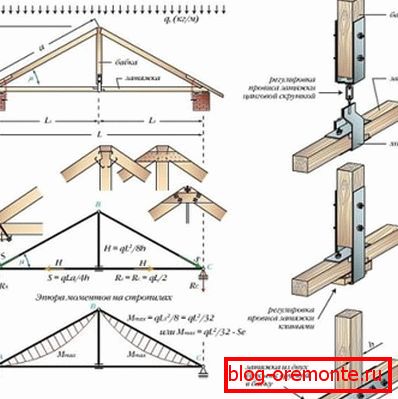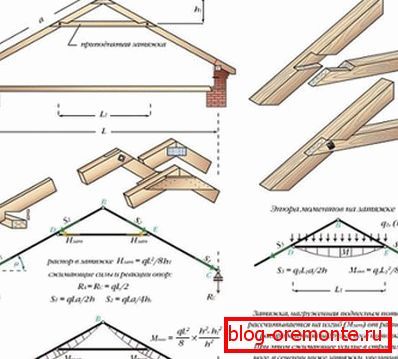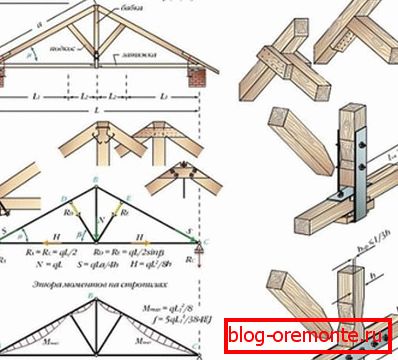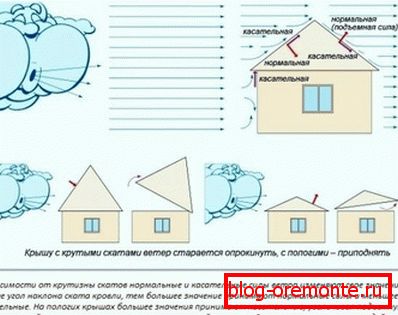Suspended roof rafters - structures, device and components
The roof is the most complex structural element of a residential, commercial or industrial building that cannot be built without accurate calculation and detailed design. Its structure consists of a waterproofing coating and a frame that is responsible for the shape, bearing capacity and reliability of the roof. There are 2 types of roof systems, differing in composition and method of connecting elements - hanging and naslonnaya. In this article we will tell what hanging rafters are, as well as how this constructive solution is applied in construction.
Functions rafters
The rafter frame is a set of supporting elements that are responsible for giving the roof shape, geometry, slope and high bearing capacity. The peculiarity of the hanging truss system is that it is being built in structures that do not have internal bearing supports. The design of the truss of such a frame is an equilateral triangle formed by rafters and tightening, therefore, it is highly resistant to external influences. The objectives of the truss frame consider:
- Formation roof slope. The roof should have a slope to effectively drain moisture during precipitation, to dump the snow mass in order to avoid the frame overload.
- Roof weight distribution. The roof structure weighs quite a lot, especially considering the additional load during snowfall. Rafters evenly distribute the weight of the coating between the bearing walls.
- Fixing roofing material. The waterproofing coating is fixed to the trunnion of the truss frame, which distributes the load and gives the coating a rigid shape.
Consider that the hanging rafters are considered to be a more stable structure of the frame, since their device helps to reduce the burr load, which affects the nodes of the naval systems.

Device naslonnyh systems
The design of the hanging truss system implies that there are no internal capital bearing supports in the overlapped structure. In this case, the rafters have a total foothold at the attachment point on the mauerlat, and with the other end of the leg they simply abut each other without using a skid bar. A truss of a hanging type is an isosceles triangle with a base equal to the width of the facade. It consists of the following elements:
- Mauerlata. This durable, flat timber of healthy hardwood with a section of 100x100 mm or 150x150 mm is placed on the upper surface of the last tier of the load-bearing walls where they will be supported by their rafter legs. This device distributes the weight of the rafters, transferring the load to the foundation.
- Rafter legs. These are the supporting elements that form the plane of the roof slopes, which are made of straight planks 50x150 mm or 100x150 mm in size. They are set in pairs with a pitch of 60-120 cm, depending on the weight and size of the finishing coating.
- Tightening. Tightening is called the horizontal element of the frame, which tightens the lower ends of the rafter legs, compensating the load on the expansion, affecting the main nodes of the roof.
- Rigel. Rigel is a top pull, which pulls together rafters in a short distance from the ridge. Since in this area the load on the expansion is greater, it is made of a bar of a thicker section.
- Grandmother. Grandma is called the hanging element of a hanging truss frame, which supports the central part of the puff under the ridge, preventing the bearing of external walls.
- Strut The struts are called horizontal supports, supporting the rafter legs in the upper or middle part, preventing the deflection of long elements.

Note! Very often, a hanging truss system does not include a power plate, since its function is successfully performed by a low-located tightening. Experienced craftsmen believe that the design of the frame without this element does not lose in any way either in strength or in reliability.
Varieties
The device of a hanging truss system largely depends on the shape and size of the structure being overlapped. The larger the area of the house, the more the construction has additional elements that increase the carrying capacity of the frame. The simplest truss is an isosceles triangle formed by rafter legs and puffs. But the longer the rafters, the more support will be needed to compensate for their deflection under their own weight. There are hanging truss systems of the following types:
- A simple tri-arch arch in the shape of a triangle. This is a sample of the simplest truss truss of the hanging type, which consists of truss legs and puffs. It is a closed triangle, the base of which works only in tension, and the sides - on deflection. Thus it is possible to block spans up to 6 meters wide.

- Three-hinged triangular arch with suspension or headstock. If the width of the overlapped structure is more than 6 meters, then the use of a solid bar for the manufacture of puffs is problematic. The wooden element of such length will sag under its own weight, so it is made of 2 separate parts and suspended from the skate with the help of the headstock.

- Three-hinged arch with a raised puff. Этот вариант висячей стропильной системы используется, если крыша относится к мансардному типу. При этом затяжку перемещают к верхней части стропильных ног ближе к коньковому соединению. Чем выше она находится, тем большее напряжение на растяжение она испытывает. При оборудовании мансарды приподнятая затяжка выполняет роль потолочных перекрытий.

- Three-hinged triangular arch with bolt. In this embodiment, the movable mount in the form of a slide, which are attached to the power plate, are replaced with fixed ones. Therefore, the bolt, which fastens the rafter pairs in the upper part, is under pressure not in tension, but in compression.

Important! If the length of the truss legs exceeds 4-4.5 meters, then with a section thickness of 50x150 mm or 100x150 mm they begin to experience a significant load on the deflection under the action of their own weight. In order to compensate for this voltage, in the upper or middle part of the rafters they are supported by a strut propped on the headstock.

Types of mounts
The roof, the frame of which is made of wood, is subjected to thermal expansion, and also slightly changes its size depending on humidity. So that these slightest changes do not lead to deformation, use a special system of fastening the construction nodes. Hanging rafters have 2 types of fasteners:
- Moving Mobile fixtures are called special devices - sliders, made of metal. With the help of them, the rafter legs are attached to the power plate, as a result of which they can slightly shift when the size of the elements changes with moisture fluctuations. Such devices prevent the deformation of the roof frame, allowing it to "breathe."
- Hard. Rigid fastening of the truss frame elements is carried out with the help of nails, self-tapping screws or metal linings. This method provides a reliable fixation, but does not compensate for thermal expansion and the change in the size of the tree with fluctuations in humidity.
Experienced craftsmen claim that it is forbidden to cut holes in the mauerlate for attaching rafter legs, since this violates the integrity of the timber and reduces its strength. When the movable fixation of the legs are attached with sliders, and with a hard one in the rafters, recesses are cut out under the mauerlat, and then nailed with nails.
Criterias of choice
Hanging rafters are considered more complex in the design and installation of a truss frame. This thin system requires careful calculation, taking into account all the loads and forces that will affect it from the inside and outside. To make the roof reliable, the choice is made in accordance with the following factors:
- Climatic conditions. To assess what wind and snow load will affect the rafters, you need to determine the climatic zone of the region in which construction is underway.
- Finishing roofing. The choice of truss frame depends on the desired roofing material, since the variant has an optimal slope angle and the recommended distance between the elements in accordance with the weight and size of the coating.
- Type of roof. The roof can be single-slope, dual-slope, hip, half-hip or hip, depending on the shape and size of the structure.
Important! Suspended roof trusses are heavy and large, so you can only lift structures that have already been assembled onto the roof with a crane. Most often, the frame is assembled directly at height, which complicates roofing work.


